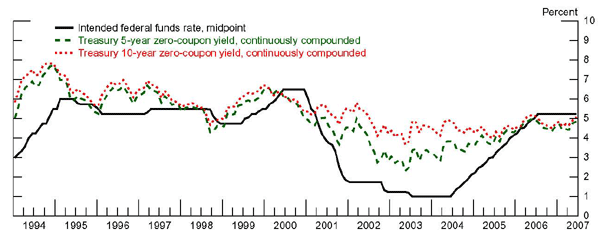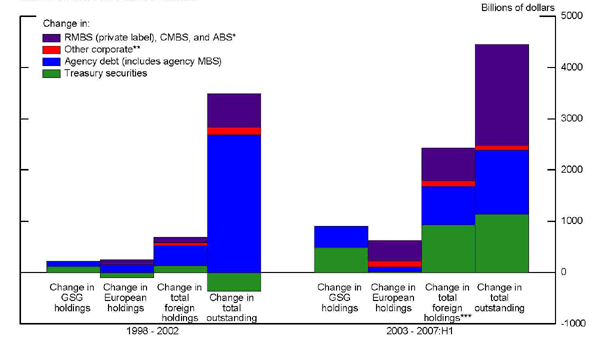FRB Foreign Holdings of and Yields
Post on: 7 Июнь, 2015 No Comment

Daniel O. Beltran, Maxwell Kretchmer, Jaime Marquez, and Charles P. Thomas
www.ssrn.com/. You are leaving the Federal Reserve Board’s web site. The web site you have selected is an external one located on another server. The Board has no responsibility for any external web site. It neither endorses the information, content, presentation, or accuracy nor makes any warranty, express or implied, regarding any external site. Thank you for visiting the Board’s web site.www.ssrn.com
Abstract:
Foreign official holdings of U.S. Treasuries increased from $400 billion in January 1994 to about $3 trillion in June 2010. Most of this growth is accounted for by a handful of emerging market economies that have been running large current account surpluses. These countries are channeling their savings through the official sector, which is then acquiring foreign exchange reserves. Any shift in policy to reduce their current account surpluses or dampen the rate of reserves accumulation would likely slow the pace of foreign official purchases of U.S. Treasuries. Would such a slowing of foreign official purchases of Treasury notes and bonds affect long-term Treasury yields? Most likely yes, and the effects appear to be large. By our estimates, if foreign official inflows into U.S. Treasuries were to decrease in a given month by $100 billion, 5-year Treasury rates would rise by about 40-60 basis points in the short run. But once we allow foreign private investors to react to the yield change induced by the shock to foreign official inflows, the long-run effect is about 20 basis points.
Keywords: Foreign official inflows, treasury yields, reserves, capital flows
JEL classification: F31, F32, F34
As economies are becoming increasingly financially integrated, longer-term bond yields are increasingly determined in international markets. This calls into question the ability of central banks to influence longer-term interest rates by the setting of short-term rates. For example, Greenspan (2005) was concerned about the failure of the longer-term interest rates to rise after the Fed began tightening monetary policy starting in mid-2004 (figure 1). During this period, foreign purchases of Treasury notes and bonds were particularly strong (figure 2), and some studies (Warnock and Warnock (2009) and Bernanke, Reinhart, and Sack (2004)) found evidence that these purchases contributed to lower bond yields. Such a decoupling of long-term interest rates from the short-term interest rate, which is set by the monetary authority, has important implications for the effectiveness of monetary policy. In addition, unexpected shifts in foreign demand for U.S. Treasuries could cloud the signals extracted from movements in long-term interest rates.
Bernanke (2005) has attributed some of the decline in long-term interest rates in the United States and other advanced economies since 2000 to a global savings glut. Indeed, global foreign exchange reserves have risen sharply since 2000 (figure 3). A significant share of global foreign exchange reserves are invested in U.S. Treasury securities- the share was 36 percent as of June 2010. As shown by the red area in figure 4, foreign official holdings of U.S. Treasuries increased from $400 billion in January 1994 to about $3 trillion in June 2010. Most of this growth is accounted for by a handful of emerging market economies that have been running large current account surpluses. Figure 5 plots the geography of total foreign holdings of U.S. Treasury securities over time. As shown by the combined pink areas, China, Japan, and the other emerging market countries experienced the fastest growth. These countries are channeling their savings through the official sector, which is then acquiring foreign exchange reserves. Any shift in policy to reduce their current account surpluses or dampen the rate of reserves accumulation would likely slow the pace of foreign official purchases of U.S. Treasuries.
Would such a slowing of foreign official purchases of Treasury securities affect their yields? As acknowledged by Wu (2005), answering this question is difficult for many reasons, most of which have not been adequately addressed in the literature. First, the direction of causation between foreign demand for Treasury securities and their prices (or yields) is likely to go both ways. Second, long-term interest rates are influenced by forward looking variables which are typically unobservable, such as expectations of long-run inflation and other macroeconomic variables, which makes identifying the effects of foreign official inflows more difficult. Third, changes in asset prices induced by shifts in foreign official demand may be, in time, partially offset by the actions of private investors. So not taking these actions into account may bias the estimated effect of foreign official purchases. Finally, data on interest rates, macroeconomic variables, and foreign holdings are often highly autocorrelated or even non-stationary, so the potential for discovering spurious relationships is great when fitting the levels of the economic time series (Granger and Newbold (1974)). The goal of this paper is to uncover the relationship between foreign purchases of U.S. Treasury securities and their yields while avoiding these traps. This task requires a more sophisticated modeling approach than the single-equation methodology popular in the literature.
The first of these traps is neglecting the interdependency between Treasury prices and foreign demand. Nearly all previous studies assume that foreign governments do not optimize their foreign reserves portfolio, thus treating foreign official inflows as exogenous. 1 However, surveys of central banks suggest that most reserve managers in fact do change their reserve portfolios in response to changes in Treasury prices and other macroeconomic variables. For example, a recent survey by the BIS found that reserve managers are increasingly behaving like private asset managers, emphasizing returns relative to liquidity and capital preservation (Borio, Galati, and Heath (2008)). 2 The BIS survey indicated that over two-thirds of central banks employ external managers, that almost all central banks use value-at-risk methodologies to measure market risk. Papaioannou, Portes, and Siourounis (2006) and others have found evidence suggesting that central banks pursue a mean-variance portfolio diversification strategy. Indeed, as shown below, our statistical tests strongly reject the null hypothesis that foreign official inflows into U.S. Treasuries are exogenous to changes in Treasury prices. Foreign private flows are also likely to be endogenous, but we did not find strong and valid instruments for them.
To address the second concern- that long-term interest rates are influenced by forward looking expectations which are typically unobservable- we use two measures of risk premia: the term-premium derived from the three-factor affine term-structure model of D’Amico, Kim, Wei (2010), and realized excess holding period returns. By construction, both of these measures of risk premia are undistorted by the effects of expected changes in the Fed’s monetary policy stance.
To avoid the potential for discovering spurious relationships from regressions on highly correlated or non-stationary data, we difference the data to obtain flow measures for our variables. By using data expressed in first differences, we are estimating the short run elasticity between foreign official flows and changes in yields. Previous studies use cumulated 12-month flows (Warnock and Warnock (2009)) and the level of foreign holdings (Bertaut, DeMarco, Kamin, and Tryon (2011)) to estimate the long-run effect on yields. However, the variables used in these studies are either highly autocorrelated, non-stationary, or trend-stationary. 3 Thus, when estimating the long-run effect, we use a cointegrated vector auto-regression (VAR) model which is suitable for regressing non-stationary variables.

Controlling for the actions of foreign private investors to any misalignments in Treasury yields induced by changes in foreign official demand requires a more sophisticated model. Foreign private investors may trade both short- and long-term securities for hedging or speculative purposes, and may also view U.S. sovereign bonds and say, German sovereign bonds as close substitutes. Our VAR model captures the interactions between foreign official and foreign private flows into long-term Treasuries.
The remainder of this paper is organized as follows. In the next section we describe the data used to estimate our models. In section 3 we examine the effects of foreign inflows into U.S. Treasuries on the term premium, using OLS, two-stage least squares, and cointegrated VAR models. The following section conducts a similar analysis on realized excess returns. In section 5 we place our results in the context of the existing literature. The last section concludes.
2.1 Interest Rates and Risk Premia
Following Dai and Singleton (2002), we define the term premium for an period bond as
where is the yield of an -period zero-coupon bond at time . and is the short rate. Equation 1 can be used to decompose the long-term rate into the expectations hypothesis (EH) component, which measures the expected path of the short rate, and the term-premium component, which measures inflation risk, liquidity risk, and other risk factors that affect the long-rate. Thus, in principle, the term premium is undistorted by the expected changes in Fed’s monetary policy stance.
The term-premium described above is a model-dependent and ex-ante measure of risk premium. But we also consider an ex-post measure of risk premia that is not model dependent: realized excess returns. More specifically, we use the holding period return from buying a 6-year bond at time and selling it as a 5-year bond 1 year later, minus the return of a 1-year bond:














